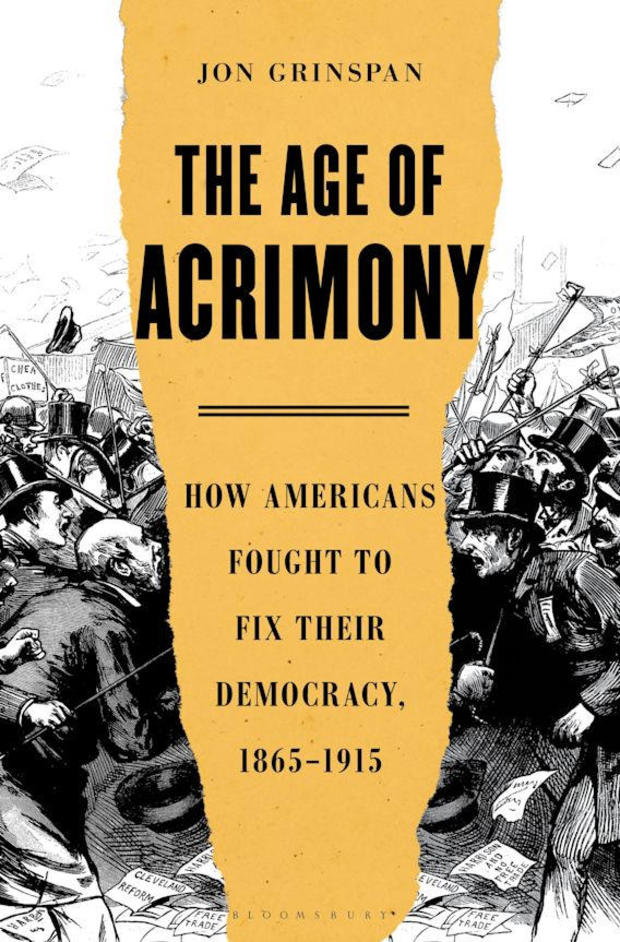Book excerpt: "The Age of Acrimony," or how American politics devolved
In his book "The Age of Acrimony: How Americans Fought to Fix Their Democracy, 1865-1915," historian Jon Grinspan, curator of political history at the Smithsonian's National Museum of American History, writes about how today's hyper-partisan and violent political discourse is not so different from how American democracy was practiced in the wake of the Civil War, and how the 20th century's more peaceful forms of political battles represented a maturation of our democracy (or, perhaps, an outlier).
Read the excerpt below, and don't miss John Dickerson's interview with Jon Grinspan on "CBS Sunday Morning" October 16!
Nearly every day while writing this book, I would walk across the National Mall. I'd pass tourists wearing MAKE AMERICA GREAT AGAIN caps and protesters waving THIS IS NOT NORMAL signs, and head into the secure vaults of the Smithsonian's National Museum of American History. Beyond the recently collected riot shields and tiki torches, I would settle into the cool, quiet aisles that preserve the deep history of our democracy.
There, century-old objects told a forgotten drama, more heated than anything we've seen. Torches from midnight rallies. Uniforms from partisan street gangs. Ballots from stolen elections. Shifting between the fractious twenty-first century and those furious nineteenth-century objects started to feel like digging at opposite ends of the same tunnel, struggling to connect in the dark. In between lay the norms of political behavior that most of us grew up with, or imagine, from America's more stable twentieth century. But the objects on the other end of that tunnel seemed to cry out: "Your normal was abnormal."
In our arguments over democracy, we have missed out on the most vital, most urgent, most relevant period of American history. Twentieth-century America's expectations of restrained public politics were a historical outlier. That civility was an invention, the end result of a brutal fight over the nature of democracy that raged across American life in the late 1800s. The objects in the Smithsonian are wreckage from that conflict; the diaries and letters stored elsewhere are battlefield reports.
We barely remember it, but this was the origin story of normal politics, the dirty tale of how democracy got clean.
Americans claim that we are more divided than we have been since the Civil War, but forget that the lifetime after the Civil War saw the loudest, roughest political campaigns in our history. From the 1860s through the early 1900s, presidential elections drew the highest turnouts ever reached, were decided by the closest margins, and witnessed the most political violence. Racist terrorism during Reconstruction, political machines that often operated as organized crime syndicates, and the brutal suppression of labor movements made this the deadliest era in American political history. The nation experienced one impeachment, two presidential elections "won" by the loser of the popular vote, and three presidential assassinations. Control of Congress rocketed back and forth, but neither party seemed capable of tackling the systemic issues disrupting Americans' lives. Driving it all, a tribal partisanship captivated the public, folding racial, ethnic, and religious identities into two warring hosts.
Critics came to consider this era democracy's "forty years in the wilderness," when America's politics threatened America's promise.
But these were not just a cartoonish "bad old days." Those eligible to vote did so as never before—averaging 77 percent turnout in presidential elections—and those denied that right fought to join in. These were the years when nationwide voting rights for African Americans and women went from utopian dreams to achievable realities. Wild rallies, bustling saloons, street-corner debates, a sarcastic press, and a love of costumes, fireworks, barbecue, and lager beer all helped heat campaigns into vibrant spectacles. The public grew used to seeing ten thousand Democrats throw their top hats in the air all at once, or watching phalanxes of Republican women dressed as goddesses float down Main Street, or eavesdropping on young girls arguing politics on streetcars. Participation was highest among the working class and poorer citizens, and often incorporated recent immigrants, young voters, and newly enfranchised African Americans. For all of the era's political ugliness, Americans chose to participate in their government as few people in world history ever had.
In an age of disruption and isolation, many found identity, friendship, and meaning in that participation. The same competitive zeal that shouted down independent thought, or sparked atrocious violence, also made politics gripping, joyful, fun. Living through a partisan American election, one critic wrote in 1894, was like watching two speeding locomotives race across an open plain. Each bystander felt irresistibly compelled to cheer for one train, to be "jubilant when it forges ahead, or mortified if it falls behind. It becomes for the time being his train, his locomotive, his railroad." Complain as they might about politics, Americans couldn't look away.
This is the fundamental paradox of their era—and perhaps of our own. Americans bemoaned the failure of their democracy, but also joined in its worst habits with a zealous fixation. An already overworked citizenry devoted incredible amounts of unpaid labor to politics. Why bother? Why turn out? In particular, why participate in a government that so many agreed was broken, rigged, and rotten?
How could a system be so popular and so unpopular at the same time?
This paradox has not been resolved, partly because we tend to associate this period with the politics of conspiracy. At the time, bigots blamed the nation's problems on Reconstruction's African American politicians, or Irish Catholic machines, or German anarchists, or Jewish socialists. Since the Progressive Era, many have focused on the (far more real) guilt of tycoons and lobbyists, in an age of yawning income inequality.
But this focus on conspiracy misses how fundamental America's political problems were. There were, to be sure, a fantastic number of scams and schemes in this era, but they were outweighed by the votes and passions of tens of millions of partisan citizens who had a greater cumulative impact. The system evolved to convince citizens to care about their government, they did, and the results were maddening. Massive public participation made it harder, not easier, to tackle the inequities of their era. It was an engaged majority, not scheming minorities, that made politics so fascinating and so frustrating.
The underlying issue of so many midnight rallies, barroom debates, drawing room lectures, and bedroom spats was the question of whether this democracy could be reformed. And then it was. While the partisan divisions of the mid-1800s ended in an atrocious civil war, Americans managed to peacefully calm the heated politics of the late nineteenth century. An incredible transformation of American politics took place around 1900, reconfiguring a public, partisan, passionate system into a more private, independent, restrained one.
It was the boldest change in political behavior since the writing of the Constitution, reprioritizing Americans' relationship with their government, with each other, and with themselves. How it happened is one of the greatest mysteries in our history.
It took a terrible bargain. The well-to-do victors of the Gilded Age's class wars chose to trade participation for civility. They restrained the old system, decreasing violence and partisanship, but diminishing public engagement along with it. Turnout crashed, falling by nearly one-third in the early twentieth century, especially among the working class, immigrants, young people, and African Americans. Our engagement has yet to recover. In the twentieth century, much of the dynamism of American public life lived outside "capital P" electoral Politics.
Instead of fixing their system, reformers broke it in a different way, one that we got used to. Much of what Americans value about their democracy was not passed down by the Founders but invented by restrainers a century later: our views on voting rights, public service, corruption, independent journalism, partisan outrage, and political violence. Few twenty-first century Americans would want to participate in elections as they looked in 1868 or 1884. Indeed, most simply could not. And the social reforms of the Progressive Era—the child labor laws and pure food acts and vaccination campaigns that made modern life livable—were only possible because a generation first quieted their politics. But much of what is wrong with our politics is of this same vintage—our inferior turnout rates, our class- and race-based divisions, our systemic discouragements for participation.
No era better highlights the nuanced trade-offs at the core of the study of history, yet, perhaps because of this, it has mostly been forgotten. So the return of angry partisanship and obsessive campaignism in the twenty-first century seems "unprecedented." It's not that our problems are the same as those of the late nineteenth century—often they are strikingly different—but that the era in between was so unusual. As the restraints of the 1900s erode, we are seeing old tendencies peek through. To understand what seems to be going wrong with our politics today, we have to ask how we got that "normal" twentieth-century democracy to begin with.
From "The Age of Acrimony: How Americans Fought to Fix Their Democracy, 1865-1915." Copyright 2021 by Jon Grinspan. Reprinted by permission of Bloomsbury.
For more info:
- "The Age of Acrimony: How Americans Fought to Fix Their Democracy, 1865-1915" by Jon Grinspan (Bloomsbury), in Hardcover, eBook and Audio formats, available via Amazon, Barnes & Noble and Indiebound




